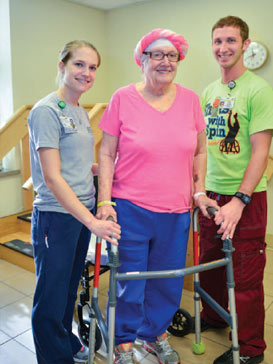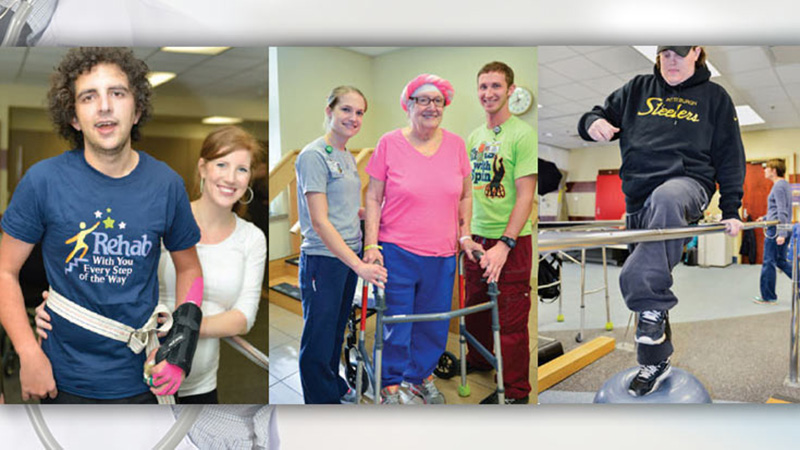 It was a triumphant return to Roper Rehabilitation Hospital. I was powered by my own two feet – not a limp in sight – appropriately dressed in street clothes (“It’s nice to see you dressed up,” Dr. Douglas McGill said.) and excited to learn about the new advances in therapy and care since my extended stay in 2010.
It was a triumphant return to Roper Rehabilitation Hospital. I was powered by my own two feet – not a limp in sight – appropriately dressed in street clothes (“It’s nice to see you dressed up,” Dr. Douglas McGill said.) and excited to learn about the new advances in therapy and care since my extended stay in 2010.
As I type these words, I am grateful to Caitlin West, who, as my occupational therapist, was charged with coaxing movement – even the smallest twitch – from my suddenly useless right hand. And when I head out for a walk, I hear my physical therapist Jessica Trego’s voice urging me to walk a little further. Struck down by a stroke, my life changed in an instant and I, quite literally, became an invalid.
I was encouraged to go to a rehab hospital for intensive therapy. I chose Roper Rehabilitation Hospital for two reasons: It was conveniently located and it was CARF (Commission on Accreditation of Rehabilitation Facilities) certified. It is the only Lowcountry hospital to hold the CARF certification, one of only three in the state accredited for stroke rehab and one of only two accredited for brain injury and spinal cord injury. I spent the better part of a month as an inpatient, followed by several weeks of additional outpatient rehab.
So when my friend – and Media Services publisher – Bill Macchio’s son suffered a traumatic brain injury, I knew Anthony could benefit from Roper’s services. He has made great strides since starting outpatient therapy, and it seems possible that one day his wheelchair will be a thing of the past.

According to Cathy Therrell, director of Roper Rehabilitation Hospital and Rehabilitation Services, about 1,100 people pass through during the course of the year, with the length of stay varying from three days to three months. The 52-bed hospital is inside the main hospital on Calhoun Street and serves patients with a variety of conditions that include stroke, spinal cord injury, brain injury, serious fractures and knee and hip joint replacements, as well as neurological disorders such as multiple sclerosis, Guillain- Barré syndrome and Parkinson’s disease. Recovery is a multifaceted team effort led by a physiatrist and involving physical therapists, occupational therapists, recreational therapists, speech and language pathologists and neuropsychologists. Social work case managers are available to help make sense of the patients’ suddenly altered lives.
Many advances have been made just in the last few years that are helping patients recover more of their lost abilities. The ReoGo is a robotic device that helps regain upper body strength essential to fight neurologic conditions. Bioness equipment helps diminish issues such as foot drop and hand function and the functional electrical stimulation bike system increases success with upper and lower body re-training. Perhaps most amazing is the ReWalk exoskeleton, which is helping spinal cord injury patients realize the dream of walking again.
Dr. Jeffrey Tubbs is the medical director at The Center for Spinal Cord Injury and is justifiably proud of the fact that 80 percent of his patients are able to return home. The CSCI schedules about a dozen outpatient appointments one day per month in addition to its inpatient rehab services.

While brain injury and stroke differ in origin, the neurological issues are often similar. The Brain Injury Program and Stroke Specialty Program both are headed by Dr. McGill. Again, patient satisfaction is high and most are able to return to their homes.
Anne Clarke has high marks for her inpatient therapy program. When her foot quit working, diagnostic tests revealed a tumor that was removed during brain surgery. Now she’s retraining her body. It is not easy, but the optimism of the staff enhances the chances for a positive outcome.
“I go to rehab and work and work,” Clarke said, referring to the intensive therapies, which average about three daily at least five days per week. “The care has been exceptional. I definitely feel the therapy is helping.”
The bar is set high both for patients and staff. Patients are expected to work hard to achieve their goals. Registered nurses are highly trained in the field and 80 percent are certified rehabilitation registered Nurses. Therapists likewise have completed rehab-specific training and earned a number of certifications. Doctors are board certified in physical medicine and rehabilitation. They are highly rated, not just because of the number of patients who are able to go home but also because of the number of patients who consider their care to be excellent. It is no wonder that patients from all over the state are attracted to the facility’s inpatient and outpatient services.
But Roper Rehab also offers one extra that doesn’t have an official certification. It is called hope.
Miracles really do happen at Roper Rehabilitation Hospital. I am one.







